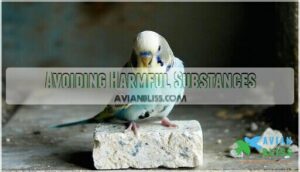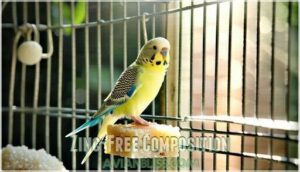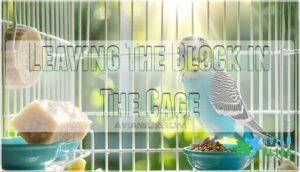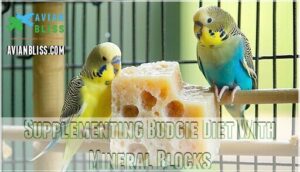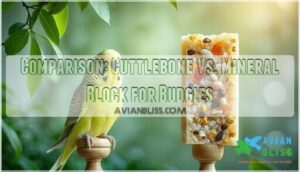This site is supported by our readers. We may earn a commission, at no cost to you, if you purchase through links.
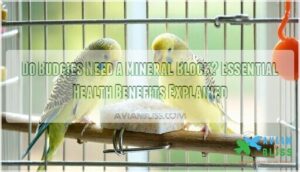
These calcium-rich blocks serve double duty – they help naturally trim your bird’s ever-growing beak while providing essential minerals like calcium and phosphorus for strong bones and overall health.
Think of them as your feathered friend’s multivitamin rather than a meal replacement. Most budgies enjoy pecking and scraping at these blocks, which also provides mental stimulation and enrichment.
Replace the block every few months to keep it fresh and effective. While a quality pellet diet covers most nutritional needs, mineral blocks offer that extra health boost many budgie owners swear by.
Table Of Contents
- Key Takeaways
- Benefits of Mineral Blocks for Budgies
- Choosing The Right Mineral Block for Budgies
- Safety of Mineral Blocks for Budgies
- Supplementing Budgie Diet With Mineral Blocks
- Comparison: Cuttlebone Vs. Mineral Block for Budgies
- Homemade Mineral Blocks for Budgies
- Frequently Asked Questions (FAQs)
- Do budgies need a mineral block?
- Why do budgies need a calcium block?
- Should budgies eat cuttlebones or mineral blocks?
- Do budgies need iodine blocks?
- Can budgies eat blocks?
- Are cuttlebones good for budgies?
- Does my budgie need a mineral block?
- Do budgies need an iodine block?
- Do birds need mineral blocks?
- Do budgies need anything in their nesting box?
- Conclusion
Key Takeaways
- You don’t absolutely need mineral blocks, but they’re smart additions – they provide essential calcium and phosphorus that seed-based diets lack while helping to trim your budgie’s beak naturally
- Choose zinc-free blocks with safe ingredients – look for calcium carbonate, oyster shell, or cuttlebone as main components and avoid artificial colors, excessive salt, or mystery additives that could harm your bird
- They’re supplements, not meal replacements – mineral blocks should complement a balanced diet of quality pellets and fresh vegetables, not substitute for proper nutrition
- Monitor usage and replace regularly – leave blocks in the cage continuously, but watch for overconsumption; replace every 2-3 months, regardless of size, and ensure proper placement away from food dishes
Benefits of Mineral Blocks for Budgies
You’ll find mineral blocks offer your budgie essential health benefits beyond just nutrition.
These blocks help maintain your bird’s beak while providing vital minerals that support overall wellness and natural behaviors.
Beak Maintenance
Mineral blocks aren’t just treats—they’re essential tools for keeping your budgie’s beak in tip-top shape.
Through natural gnawing and chewing instincts, these blocks help prevent overgrown beaks that can cause serious health problems.
Nature’s dental care in a block—your budgie’s beak stays healthy through instinctive gnawing and trimming action.
Your budgie’s constant pecking and beak trimming action keeps their beak properly sized and sharp, think of it as nature’s nail file—the abrasive texture naturally wears down excess growth while satisfying those instinctive urges to chew and explore.
These blocks also help to provide the necessary beak filing that budgies need, which is crucial for their beak health and overall well-being, making them a vital part of beak care.
Beak Health
A healthy budgie mineral block serves as nature’s toolkit for maintaining ideal beak health.
Your feathered friend’s chewing habits naturally trim and strengthen their beak, preventing beak overgrowth that can lead to serious complications.
These blocks provide essential minerals that support beak strength and help prevent beak deformities.
The natural trimming action keeps your budgie’s beak properly aligned and functional.
Regular access to quality mineral blocks guarantees your pet maintains excellent budgie beak health throughout their lifetime.
The mineral block benefits extend beyond basic maintenance, supporting overall well-being and natural behaviors, which is essential for your pet’s overall well-being.
Choosing The Right Mineral Block for Budgies
Not all mineral blocks are created equal, so you’ll want to check what’s actually inside before hanging one in your budgie’s cage.
Look for blocks that list safe ingredients like calcium carbonate, oyster shell, or cuttlebone as main components, and steer clear of anything containing artificial colors, excessive salt, or mystery additives that could harm your feathered friend, ensuring the blocks are made with natural components and avoiding those with artificial colors.
Checking Ingredients
When selecting a budgie mineral block, you’ll want to scrutinize the ingredient list like you’re reading a recipe for your feathered friend. Quality matters more than flashy packaging or marketing claims.
- Natural mineral sources: Look for blocks containing cuttlebone, oyster shell, or crushed eggshells as primary calcium sources
- Safe binder types: Choose blocks using natural binders like clay or calcium carbonate rather than synthetic additives
- Harmful additives: Avoid products with artificial colors, flavors, or preservatives that offer no nutritional value
Safe brands typically list clear ingredient ratios and mineral sources on their packaging. You can even find information about various block ingredients online.
The best budgie mineral block ingredients read like a short grocery list – simple and recognizable. Remember, your bird’s health depends on these mineral block benefits, so don’t compromise on quality for convenience.
Avoiding Harmful Substances
When choosing mineral blocks for your budgie, you’ll want to avoid products containing toxic ingredients that could harm your feathered friend. Look for blocks from reputable brands that prioritize quality control and use safe binders rather than questionable additives.
Stay away from blocks containing:
- Heavy metals like zinc, lead, or arsenic
- Artificial colorings, flavorings, or industrial-grade plaster
These contamination risks can cause serious health issues. Always check labels carefully, as some mineral block risks include mold and bacteria growth from poor manufacturing.
Ensuring a balanced diet is vital, as mineral blocks should supplement, not replace, a varied diet, to boost your budgie’s health. Choose products with clear ingredient lists and avoid blocks designed for other animals, which may contain additive concerns specific to budgies.
Clip Safety
When securing mineral blocks to your budgie’s cage, clip material and attachment methods matter substantially for bird safety.
Metal clips with sharp edges pose entanglement hazards that can cause serious budgie injury during normal interaction.
Choose clips made from bird-safe materials without toxic coatings or rust-prone surfaces.
Plastic clips often provide safer alternatives, though they may wear faster.
It’s important to source certified bird-safe clips for your pet.
Inspect attachment points regularly for damage or loosening that could create gaps where tiny feet might get trapped.
Proper clip selection protects your budgie while ensuring reliable access to essential minerals for ideal budgie health and bird care.
Safety of Mineral Blocks for Budgies
While mineral blocks offer many benefits for budgies, you’ll want to make certain they’re safe before placing them in your bird’s cage.
The key is choosing blocks with zinc-free composition and understanding proper placement to keep your feathered friend healthy and happy.
Zinc-Free Composition
Zinc poses serious toxicity concerns for budgie health, making zinc-free mineral blocks your safest choice.
This heavy metal accumulates in your bird’s organs, causing long-term effects like liver damage and neurological problems.
When ingredient sourcing, look for natural alternatives like calcium carbonate, oyster shell, and cuttlebone instead of zinc compounds. Safe binders such as food-grade clay help hold these mineral blocks together without harmful additives.
Choosing zinc-free options prevents mineral deficiency while protecting your budgie from potential poisoning that could threaten their well-being.
Newly galvanized wire is a common source of zinc, but vinegar treatments help to make it safer, ensuring a healthy environment for your budgie and preventing potential poisoning.
Leaving The Block in The Cage
You can safely leave mineral blocks in your budgie’s cage continuously, providing constant access to essential minerals.
Monitor consumption patterns to confirm your bird isn’t overindulging, as excessive intake can cause health issues.
Practice good block hygiene by cleaning around the placement area weekly and maintaining a strategic placement away from food dishes.
For safe mineral options, consider exploring online retailers.
Replace blocks every 2-3 months regardless of size, as older blocks lose nutritional value.
This replacement frequency guarantees your budgie receives fresh mineral sources while supporting proper budgie care and balanced bird nutrition throughout their daily routine.
Supplementing Budgie Diet With Mineral Blocks
While mineral blocks aren’t absolutely essential for budgies, they provide valuable supplementation that most seed-based diets lack.
You’ll find they’re particularly helpful for filling nutritional gaps, especially calcium and other trace minerals that support your budgie’s overall health.
Not a Substitute for a Good Diet
Mineral blocks aren’t a magic solution for budgie nutrition. While they provide valuable calcium and trace minerals, they can’t replace the foundation of balanced nutrition your bird needs. Think of them as vitamin supplements for humans – helpful additions, not meal replacements.
Seed-only diets lack essential nutrients, making mineral blocks seem more important than they actually are. Here’s what you need to know:
- Pellet diets provide more complete nutrition than seeds alone
- Seed limitations include poor calcium-to-phosphorus ratios and missing vitamins
- Supplement reliance can create nutritional imbalances if overdone
- Holistic health requires varied foods, not just mineral block supplementation
Your budgie’s diet should include high-quality pellets, fresh vegetables, and occasional fruits. A varied diet helps prevent selective eating habits, guaranteeing maximal nutrition. Bird nutrition experts recommend pellets as the base, with mineral blocks serving as occasional supplements. This approach guarantees your budgie gets thorough bird diet benefits rather than depending on one source for mineral needs.
Supplementing Calcium and Minerals
When should you worry about seed calcium deficiency in your budgie’s diet? The answer lies in understanding that seeds alone can’t meet your bird’s nutritional needs.
Most budgies face calcium shortages because seeds contain minimal calcium and poor phosphorus absorption. Mineral blocks bridge this gap, providing essential calcium and iodine your feathered friend needs for strong bones and healthy feathers.
However, watch for mineral block overdose – moderation matters. These supplements support budgie nutrition and bird health when used properly.
Remember, dietary balance is key. Too little calcium weakens bones, while excess can cause kidney issues. Monitor your budgie’s consumption to maintain ideal health.
Fresh Fruits and Vegetables
While mineral blocks provide calcium and phosphorus, fresh fruits and vegetables offer essential vitamins your budgie needs for peak health.
These colorful additions support your healthy budgie diet by delivering nutrients that mineral blocks can’t provide alone.
- Nutrient Variety: Offer different fruits and vegetables weekly to guarantee comprehensive budgie nutrition beyond basic mineral supplementation.
- Safe Options: Choose bird-safe produce like apples, carrots, and leafy greens while avoiding avocado, chocolate, and high-salt foods.
- Preparation Methods: Wash thoroughly, cut into appropriate portion sizes, and remove daily to prevent spoilage risks in your budgie’s environment.
Comparison: Cuttlebone Vs. Mineral Block for Budgies
When choosing between cuttlebone and mineral blocks for your budgie, you’re looking at two effective options that serve different purposes.
Cuttlebone provides pure calcium and helps maintain beak health, while mineral blocks offer a broader range of nutrients including calcium, phosphorus, and iodine for overall wellness.
Function and Benefits
Understanding your budgie’s mineral needs helps you choose between cuttlebone and mineral blocks wisely.
Both options support calcium for budgies and prevent deficiencies, but they serve slightly different purposes in your bird’s diet.
Cuttlebone naturally provides calcium carbonate for bone development, while mineral blocks deliver thorough mineral supplementation including iodine for budgies.
This broader spectrum supports feather condition and metabolic processes more completely than cuttlebone alone.
Budgies are susceptible to iodine deficiency symptoms, which can be prevented with proper mineral supplementation.
| Function | Cuttlebone | Mineral Block |
|---|---|---|
| Primary Benefit | Calcium source | Multiple essential minerals |
| Health Support | Bone strength | Complete nutrition |
| Added Value | Beak maintenance | Prevents mineral deficiency |
Mineral blocks offer superior nutritional coverage, addressing various essential minerals your budgie needs for peak health and vitality.
Placement and Maintenance
Proper placement makes all the difference in how your budgie interacts with these bird cage accessories.
Secure both cuttlebone and mineral blocks near perches using cage clips, ensuring Block Accessibility without obstructing movement.
Monitor Consumption Monitoring weekly – replace when worn or soiled to maintain Hygiene Practices.
Strategic Cage Location away from food dishes prevents contamination while encouraging natural foraging in your bird habitat.
| Maintenance Task | Frequency |
|---|---|
| Check for wear/damage | Weekly |
| Clean surrounding area | Every 3-4 days |
| Replace cuttlebone | Monthly or when depleted |
| Replace mineral block | Every 2-3 months |
| Inspect cage clips | During each cleaning |
Smart Replacement Frequency keeps your bird environment healthy and your budgie happy.
Homemade Mineral Blocks for Budgies
Making your own mineral blocks gives you complete control over ingredients and guarantees freshness for your budgie’s health.
You can customize the recipe to match your bird’s specific needs while avoiding unnecessary additives found in commercial options, which is crucial for your bird’s health.
DIY Recipe
You can create effective homemade mineral blocks using simple Ingredient Selection and proper Mixing Techniques. Start with these core components:
- Food-grade calcium carbonate (6 parts)
- Crushed eggshells or cuttlebone powder (3 parts)
- Non-toxic clay as Binding Agents (2 parts)
- Powdered kelp for iodine (1 part)
- Fine charcoal for digestive support (1 part)
- Sea salt for trace minerals (small pinch)
Mix dry ingredients thoroughly, then add water gradually until you achieve a thick paste. Pour into molds and insert hanging wires.
Drying Methods require 24-48 hours at room temperature. You can substitute honey or gelatin for clay if preferred. Store finished blocks in dry conditions for Safe Consumption.
Ensuring Safety and Quality
Quality control starts with trusted ingredients and proper preparation. Choose safe brands with clear ingredient lists, avoiding blocks with harmful additives or questionable binders.
Check block hardness—it should be firm enough to last but soft enough for safe chewing. Monitor consumption regularly to prevent oversupplementation, which can cause health issues.
Watch for contamination signs like mold or bacteria, especially in humid conditions. Replace blocks showing wear or discoloration immediately.
Creating a comfortable environment with suitable nesting materials is also important for budgie well-being. If you notice unusual eating patterns or health changes, seek vet consultation promptly for mineral block safety guidance.
Frequently Asked Questions (FAQs)
Do budgies need a mineral block?
An ounce of prevention is worth a pound of cure.
Yes, budgies need mineral blocks because their seed-based diets lack essential calcium, phosphorus, and iodine required for strong bones, healthy feathers, and proper thyroid function, which is why mineral blocks are a necessity.
Why do budgies need a calcium block?
Budgies need calcium blocks because seed-based diets don’t provide enough calcium for strong bones, healthy feathers, and proper egg formation. They’ll naturally nibble these blocks while keeping their beaks trim.
Should budgies eat cuttlebones or mineral blocks?
Your feathered friend’s nutritional needs deserve thoughtful consideration.
You’ll want to offer both cuttlebone and mineral blocks since they complement each other perfectly—cuttlebone provides essential calcium while mineral blocks deliver broader nutritional support including iodine and trace elements for peak health.
Do budgies need iodine blocks?
Your budgie benefits from iodine blocks as they provide essential iodine for proper thyroid function and vibrant feather development.
Most seed-based diets lack adequate iodine, making these blocks a valuable supplement.
Can budgies eat blocks?
Like knights of old needed their trusty steeds, your budgie needs mineral blocks for peak health.
These blocks provide essential calcium, phosphorus, and iodine while supporting beak maintenance and mental stimulation through natural chewing behavior.
Are cuttlebones good for budgies?
Yes, cuttlebones are excellent for budgies.
They’re a natural calcium source that helps maintain strong bones and healthy beaks.
Your budgie will also enjoy gnawing on them, which provides mental stimulation and naturally trims their beak.
Does my budgie need a mineral block?
Most budgies benefit from mineral blocks since seed-based diets lack sufficient calcium and phosphorus.
They support bone health, egg production, and beak maintenance while providing mental stimulation through natural chewing behavior, which is essential for their overall well-being and health.
Do budgies need an iodine block?
Want to keep your budgie’s thyroid healthy?
An iodine block isn’t typically necessary—quality mineral blocks already contain adequate iodine for thyroid function and feather development, making separate iodine supplementation redundant.
Do birds need mineral blocks?
Birds generally benefit from mineral blocks, especially those on seed-based diets.
These blocks provide essential calcium, phosphorus, and iodine that support bone health, feather development, and proper metabolism while encouraging natural beak maintenance, which is crucial for metabolism.
Do budgies need anything in their nesting box?
What’s the secret to successful budgie breeding?
You’ll need soft nesting materials like coconut fiber, paper strips, or commercial nesting material.
Skip sawdust or cedar shavings—they’re harmful.
Keep the box clean, dry, and appropriately sized for your feathered friends.
Conclusion
Better safe than sorry – that’s the golden rule when caring for your feathered companion.
While budgies don’t absolutely need mineral blocks, they’re valuable additions to your bird’s wellness routine.
These calcium-rich supplements support beak maintenance, provide essential minerals, and offer mental stimulation through natural pecking behaviors.
Whether you choose commercial blocks or homemade alternatives, make certain they’re zinc-free and properly positioned.
Remember, do budgies need a mineral block? Not strictly, but they’ll certainly benefit from having one available alongside their balanced diet.
- https://www.marionzoological.com/docs/TheNutritionoftheBudgerigar.pdf
- https://www.omlet.us/guide/parakeets/parakeet_food/minerals/
- https://hari.ca/shop/supplements/mineral-blocks/
- https://www.youtube.com/watch?v=-wxe6BpAnFQ
- https://forums.avianavenue.com/index.php?threads%2Fcan-mineral-block-actually-safe-gor-birds.220598%2F


